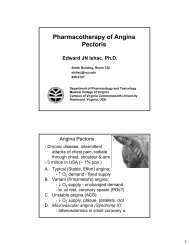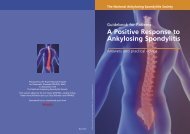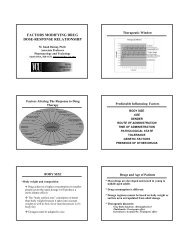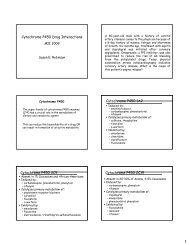The Autonomic Nervous System Introduction Autonomic Nervous ...
The Autonomic Nervous System Introduction Autonomic Nervous ...
The Autonomic Nervous System Introduction Autonomic Nervous ...
Create successful ePaper yourself
Turn your PDF publications into a flip-book with our unique Google optimized e-Paper software.
<strong>The</strong> <strong>Autonomic</strong> <strong>Nervous</strong> <strong>System</strong><br />
<strong>Introduction</strong><br />
Edward JN Ishac, Ph.D.<br />
Professor<br />
Smith Building, Room 742<br />
eishac@vcu.edu<br />
828 2127<br />
Department of Pharmacology and Toxicology<br />
Medical College of Virginia<br />
Campus of Virginia Commonwealth University<br />
Richmond, Virginia, USA<br />
<strong>Autonomic</strong> <strong>Nervous</strong> <strong>System</strong> - Overview<br />
www2.courses.vcu.edu/ptxed/ptx/<br />
1. Tissues / Organs: - receptors present,<br />
tissue / organ response<br />
2. Transmitters: - NE, Ach, synthesis, storage,<br />
release, regulation<br />
3. Drugs: - receptor selectivity,<br />
mechanism of action<br />
4. Can predict: - clinical application, side effects,<br />
toxicity, treatment of toxicity<br />
5. Eye Anatomy: - miosis, mydriasis, cycloplegia,<br />
wide- vs narrow-angle, Horner’s syn.<br />
6. General: - learn by drug classes, important<br />
adverse reactions, not dosage<br />
1
ANS – Overview Tissues/Organs<br />
Sympathetic NS<br />
Parasympathetic NS<br />
Cardiovascular <strong>System</strong><br />
Organ<br />
Action<br />
Receptor<br />
Action<br />
Receptor<br />
BP = CO X TPR,<br />
CO = SV X HR<br />
Eye: Radial m.<br />
Mydriasis<br />
α 1<br />
Reflexes oppose direct action to correct BP<br />
change (not HR change)<br />
Circular m.<br />
Miosis<br />
M 2 , M 3<br />
Ciliary m.<br />
Contract<br />
M 3<br />
Receptor<br />
Action<br />
Heart:<br />
↑HR, ↑force<br />
β 1<br />
↓HR<br />
M 2<br />
α 1<br />
vasoconstriction→↑TPR →↑BP<br />
Vascular muscle<br />
Constrict<br />
α 1<br />
Relax<br />
M 3 (NO)<br />
β 1<br />
↑HR → ↑CO → ↑BP<br />
Relax<br />
β 2 , D 15 renal<br />
β 2<br />
vasodilation →↓TPR → ↓BP<br />
Bronchial m.<br />
Relax<br />
β 2<br />
Contract<br />
M 3<br />
M 2<br />
(vagus) ↓HR → ↓CO → ↓BP<br />
GI-tract<br />
↓ motility<br />
α 1 , β 2<br />
↑ motility<br />
M 3<br />
M 3<br />
(NO) relaxation→ ↓TPR → ↓BP<br />
Sphincter m.<br />
Contract<br />
α 1<br />
Relax<br />
M 3<br />
Genitourinary m.<br />
Relax<br />
β 2<br />
Contract<br />
M 3<br />
Cardiovascular Drug Effects<br />
Penis<br />
Ejaculation<br />
α<br />
Erection<br />
M<br />
Norepinephrine<br />
↑BP,<br />
↓HR (reflex)<br />
Uterus<br />
Relax<br />
β 2<br />
NO = Nitric oxide<br />
Isoproterenol<br />
BP (o/-), ↑HR,<br />
↑PP<br />
Pilomotor<br />
Contract<br />
α<br />
2 nd Messengers<br />
Epinephrine<br />
↑BP, ↑HR, ↑PP<br />
Sweat glands<br />
↑ secretion<br />
M 3<br />
β 123 D 15<br />
↑cAMP<br />
Mecamylamine<br />
↓BP,<br />
(o/+) HR<br />
Liver<br />
↑ glucose<br />
β 2<br />
α 1 M 135<br />
↑IP 3 / Ca 2+<br />
Propranolol<br />
BP (o/-), ↓HR<br />
Kidney<br />
↑ renin<br />
β 1<br />
α 2 M 24 D 234<br />
↓cAMP<br />
Atropine<br />
BP (o/-), ↑HR<br />
Fat cell<br />
Lipolysis<br />
β 3<br />
N n<br />
N m<br />
Na + in<br />
K+ out<br />
Phentolamine<br />
↓BP, ↑HR (reflex),<br />
↑PP<br />
Summary Table<br />
Indented = similar action to parent compound Most important agent, important, least important [ ] = questionable therapeutic value<br />
I =drug interactions S = side effects T = toxicity CV = cardiovascular system CNS = central nervous system<br />
Agent (trade name®)<br />
Adrenoceptor Agonists<br />
<strong>The</strong>rapeutic Use<br />
Notes<br />
MAOI = Monoamine oxidase inhibitors TCA = Tricyclic antidepressants<br />
Norepinephrine<br />
(Levarterenol)<br />
Hypotension, pressor agent<br />
α / β 1 β 3 (β 2 ) neuronal, non-circulating, I: MAOI, TCA<br />
Epinephrine<br />
(generic)<br />
Allergic reactions (DOC), shock, CPR<br />
α / β 1 β 2 (β 3 ) adrenal medulla, circulating; I: MAOI, TCA<br />
Dopamine<br />
(Intropin)<br />
Shock (DOC)<br />
α 1 / β 1 / D, NE precursor, renal vasodilatation? I: MAOI<br />
Isoproterenol<br />
(Isuprel)<br />
Asthma, cardiac stimulant<br />
β, synthetic, not endogenous; BP(↓, --) HR↑<br />
Phenylephrine<br />
Methoxamine<br />
(Neosynephrine)<br />
(Vasoxyl)<br />
Nasal decongestant, hypotension<br />
Hypotension, pressor agent<br />
α 1 Not commonly used for hypotension; S: CV, reflex<br />
bradycardia<br />
Metaraminol<br />
(Aramine)<br />
Hypotension, pressor agent<br />
α, orally active; NE or DA better choice<br />
Clonidine<br />
Guanfacine<br />
α-methyl-dopa<br />
(Catapres)<br />
(Tenex)<br />
(Aldomet)<br />
Hypertension<br />
α 2 , ↓ cns sympathetic outflow, inhibit NE release, rebound<br />
HT; S: dry mouth, sedation, impotence.<br />
α-methyl-dopa is metabolized to α-methyl-NE (α 2 -agonist,<br />
positive Coombs test)<br />
Dobutamine<br />
(Dobutrex)<br />
CHF, cardiac stimulant<br />
β 1, iv infusion, tolerance, desensitization<br />
Prenalterol<br />
Albuterol<br />
Ritodrine<br />
Metaproterenol<br />
(Proventil, Ventolin)<br />
(Yutopar)<br />
(Alupent)<br />
Asthma - bronchodilator<br />
Premature labor<br />
Asthma<br />
β 2 --selective, Oral 1-2 hrs onset 4-6 hrs duration,<br />
Inhalation 5-10 min onset 3-4 hrs duration;<br />
S: cardiovascular; less via inhalation<br />
Note: Terbutaline not FDA approved for premature labor<br />
(cheaper, longer lasting than Ritodrine)<br />
Terbutaline<br />
(Brethaire)<br />
Asthma, (premature labor)<br />
2
<strong>Autonomic</strong> <strong>Nervous</strong> <strong>System</strong><br />
<strong>Autonomic</strong> <strong>Nervous</strong> <strong>System</strong><br />
SYMPATHETIC<br />
Thoracolumbar<br />
T1-12, L1-3<br />
PARASYMPATHETIC<br />
Craniosacral<br />
Cranial N. III, VII, IX, X<br />
Sacral S2-3<br />
“Flight or Fight”<br />
↑BP, ↑HR, ↓GIT<br />
“Feeding & Breeding”<br />
↓BP, ↓HR, ↑GIT<br />
FUNCTIONS CONTROLLED<br />
Respiration<br />
Circulation<br />
Body Temperature<br />
Metabolism<br />
Sweating<br />
Secretions<br />
CENTRAL INVOLVEMENT<br />
Hypothalamus - Integration, body<br />
temp & water balance<br />
Medulla - BP, respiration<br />
Cerebral cortex - somatic NS & ANS<br />
integration<br />
3
Activation of SNS and release<br />
of NE & EPI from nerve<br />
endings and adrenal gland<br />
Increase blood flow, BP, HR,<br />
glucose, pupil dilation<br />
Decrease activity of digestive<br />
& immune system<br />
Fight or Flight<br />
Exam Stress<br />
Normal BP: 120 / 80 mmHg HR: 72 bpm<br />
Before exam: 140 / 99 mmHg HR: 97 bpm<br />
During exam: 179 / 149 mmHg HR: 110 bpm<br />
End of exam: 111 / 74 mmHg HR: 76 bpm<br />
4
Neurons of the ANS<br />
Key Points<br />
Preganglionic fibers<br />
– mylinated<br />
Postganglionic fibers<br />
– non mylinated<br />
SNS pre : post 1:20<br />
PNS pre : post 1:1<br />
(exception 1:10,000<br />
Auerbachs plexus)<br />
Key role of Ach<br />
Motor fiber not part of ANS<br />
Neurons of the ANS<br />
5
Adrenoreceptors<br />
Alpha<br />
Beta<br />
Dopamine<br />
α 1<br />
-<br />
α 2<br />
-<br />
β 1<br />
-<br />
β 2<br />
-<br />
β 3<br />
-<br />
D 1-5 -<br />
Vascular smooth muscle<br />
Nerve terminals<br />
Cardiac muscle<br />
Bronchial smooth muscle<br />
Fat cells<br />
Renal, vascular smooth<br />
muscle (D 1 -)<br />
Cholinoreceptors<br />
Muscarinic<br />
M 1<br />
-<br />
M 2<br />
-<br />
M 3<br />
-<br />
Ganglia cells<br />
Cardiac muscle<br />
Sweat glands<br />
Nicotinic<br />
M 4<br />
/M 5<br />
N N<br />
-<br />
N M<br />
-<br />
Ganglia cells<br />
Neuromuscular junction<br />
6
ANS Diagram<br />
Key Points<br />
Division – Anatomical<br />
Usually dual innervation<br />
Usually antagonistic<br />
Usually some ANS “tone”<br />
Usually one dominates<br />
Role of reflex responses<br />
Raynaud’s Syndrome<br />
• Excessive sympathetic tone in nerves<br />
supplying hands and feet. Minor cold,<br />
or even thought of cold, causes<br />
pronounced vasoconstriction that can<br />
be severe enough to cause necrosis of<br />
tissues<br />
• Discoloration of the fingers and/or toes<br />
when the patient is exposed to changes<br />
in temperature (cold or hot) or<br />
emotional events<br />
• Abnormal spasm of blood vessels<br />
causes diminished blood supply<br />
• Initially, the digit(s) turn white because<br />
of diminished blood supply.<br />
• <strong>The</strong>n turn blue because of prolonged<br />
lack of oxygen<br />
• Finally turn red, the blood vessels<br />
reopen, causing a local "flushing"<br />
• Three-phase color sequence (white to<br />
blue to red) is typical<br />
• Treatment: Ca++ blockers if severe<br />
7









